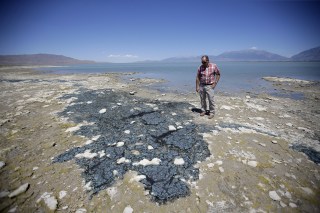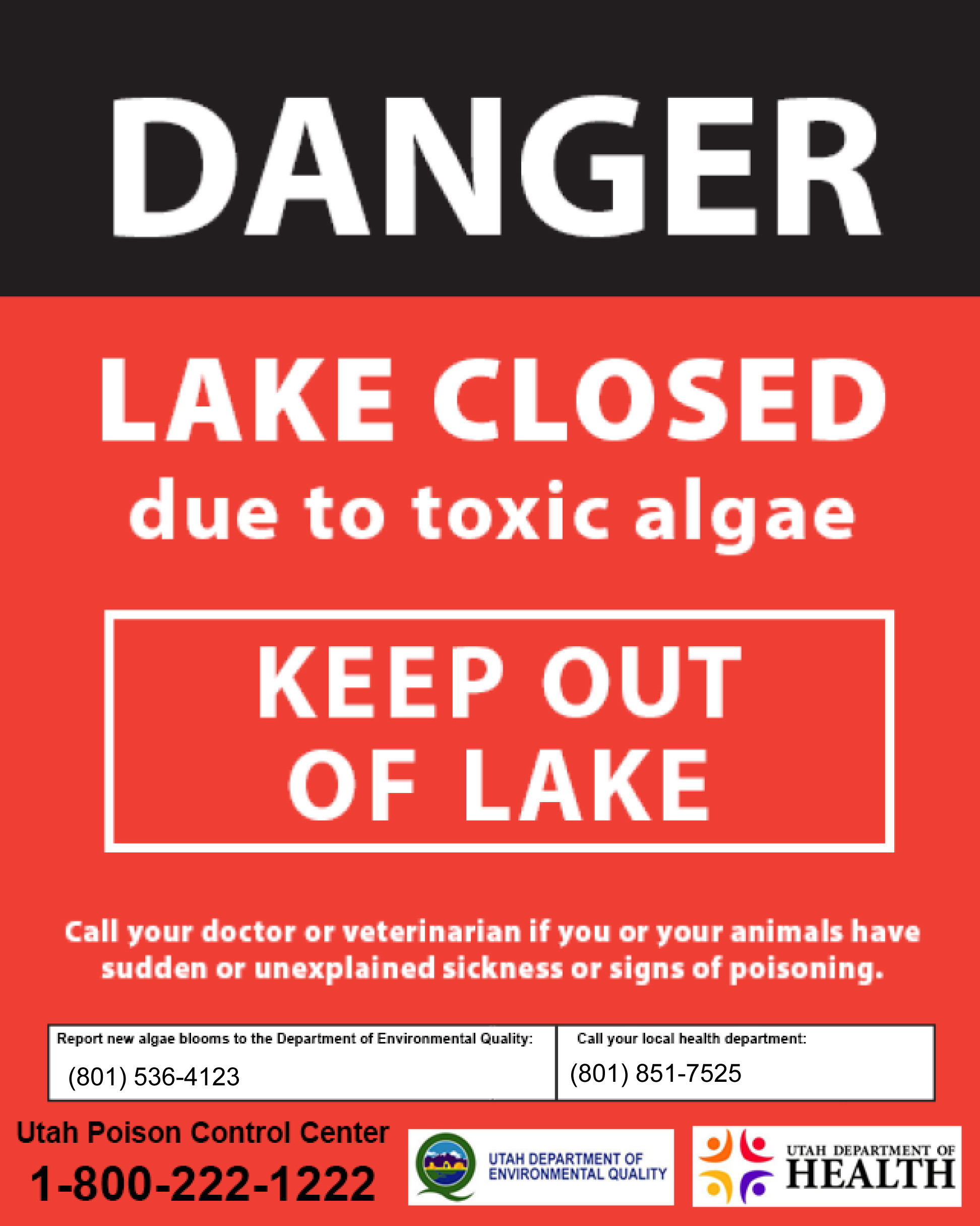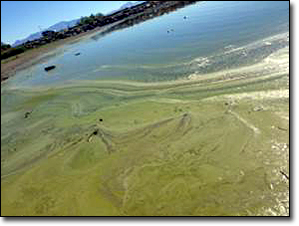Toxic Algae Closes Utah Lake, Sickens 100
by Associated Press
A huge toxic algae bloom in Utah has closed one of the largest freshwater lakes west of the Mississippi River, sickening more than 100 people and leaving farmers scrambling for clean water during some of the hottest days of the year.
The bacteria commonly known as blue-green algae has spread rapidly to cover almost all of 150-square-mile Utah Lake, turning the water bright, anti-freeze green with a pea soup texture and leaving scummy foam along the shore.

Bryce Larsen, environmental health director at the Utah County Health Department, looks at dried algae on the shore of Utah Lake on July 20 near Spanish Fork, Utah. Rick Bowmer / AP
"It smells like something is rotting," said Jason Garrett, water quality director for the Utah County Health Department. "We don't have an idea of how long this event will last." "It smells like something is rotting."
Toxic algae is a problem around the country. An enormous bloom in Florida is now fouling beaches on the Atlantic coast, and a 2014 outbreak at Lake Erie left more than 400,000 people in the Toledo area without tap water for two days.
Utah Lake doesn't provide drinking water, but its closure is causing big problems for people who use the lake for swimming, fishing and other activities and for farmers with thirsty crops.
Utah Poison Control says it has fielded hundreds of calls related to the bloom, including 130 involving people who have reported vomiting, diarrhea, headache and rashes.
The contamination has now spread to the Jordan River, which supplies irrigation to dozens of farmers around Salt Lake City, about 45 miles north of the lake. The problem has occurred amid days of triple-digit temperatures as growers prepare for farmers markets and try to nurture crops such as corn and fruit trees at key points in their development.
"We've spent hundreds of thousands of dollars on this crop, maxed out every dollar we have," said Luke Petersen, who farms about 100 acres of tomatoes, summer squash and other produce in Riverton. "We're real worried about it."
Meanwhile, the Bonneville School of Sailing has had to cancel more than a dozen groups since the lake was closed.
"This will be a real hit," said co-owner Todd Frye. He loves the mountain-rimmed lake and has worked to change the decades-old perception that it's murky and polluted. New efforts to clean out bottom-feeding carp are improving the water quality, but he worries the algae bloom will be a blow to its image.
The lake is largely fed by treated wastewater as well as agricultural runoff, said Erica Gaddis, assistant director for the Utah Division of Water Quality. "We've been loading the Utah Lake in one form or another for 150 years, and it's catching up with us."
Long-standing drought conditions have made the water especially low and stagnant. Combine that with hot summer weather and Utah Lake became a perfect petri dish for the cyanobacteria.
There are chemical and biological treatments for the problem, but using them on such a large bloom would be unprecedented and possibly harmful, Gaddis said.
For now, authorities are waiting for the bloom to run its course and clear, hopefully aided by a drop in temperatures or a storm that could stir up the water and reduce stagnation.
One bit of good news is that early test results indicate levels of dangerous toxins produced by the bacteria may not be as high as feared, though the state is still waiting for more data.
To stave off new blooms in coming years, the state is looking to reduce the levels of toxic algae-feeding phosphorous and nitrogen in wastewater that's pumped into the lake. That could be difficult, however, because cities served by those plants include some of the fastest-growing in the country.
"We've been loading the Utah Lake in one form or another for 150 years, and it's catching up with us," Gaddis said.
=============================
Utah Lake’s Poop-Driven Algal Bloom Is a Crappy Situation
 Boats sail through bright green water caused by an algae bloom near the Lindon Marina in Utah Lake.Rick Egan/AP
Boats sail through bright green water caused by an algae bloom near the Lindon Marina in Utah Lake.Rick Egan/AP Algae swamped Utah Lake last week, stretching over 134 square miles. The bright green bloom is mesmerizing — and possibly toxic. And, turns out, poop is partly to blame.
This stunning (and kind of gross) aerial captured by Salt Lake Tribune photographer Rick Egan shows the algae choking the water near the Utah Lake’s marina. The bloom was discovered around July 12, and at its peak covered 90 percent the water’s surface, spreading north up the Jordan River toward the Great Salt Lake. High levels of cyanobacteria caused public health officials to close the lake for further testing, and posted signs warning unsuspecting visitors to keep out.
So what made the green goo? The Utah Department of Environmental Quality blames the bloom on a possible combination of high temperatures and low lake levels that increased the concentration of phosphorus, which helps algae grow. Over 76 percent of that phosphorus arrives to the lake through discharge from eight nearby wastewater treatment plants. As UDEQ spokesperson Donna Spangler kindly puts it, “It comes from people using the bathroom.”
Public health officials closed the lake on Friday. Spangler says they’re waiting on test results to show whether or not the algae cells are actually releasing toxins in the water. There have been 500 calls to poison control, mostly from people who were out on the water and later experienced symptoms like vomiting, headache and skin rash.
Utah Lake is no outlier. According to David Caron, professor of biological sciences at the University of Southern California, freshwater blooms are becoming more frequent as temperatures warm. One solution would be for cities to upgrade their sewage treatment plants to remove nutrients before they ever hit the water. But it’s expensive, so some choose to dump algae-killing toxic chemicals like copper sulphate into lakes or add clay that binds up phosphorus at the bottom, where it sits indefinitely.
The UDEQ plans to let the bloom clear up by itself. It typically takes a week or two, though the toxins can persist for days afterward—just something to think about next time you flush.
==============================
Utah Lake Closed Due To Harmful Algae Bloom
SALT LAKE CITY (DEQ) – Public health officials have decided to close Utah Lake, effective immediately, due to a large, harmful algal bloom that may pose a serious health risk to the public and animals.The Utah Department of Health (UDOH) and Utah County Health Department (UCHD) say lab results for samples collected by the Utah Department of Environmental Quality (DEQ) show the concentration of algal cells in the water are three times the threshold for closing a body of water.
According to Dr. Joseph Miner, Executive Director of the Utah Department of Health, “These types of algae release neurotoxins and hepatotoxins, that can affect brain, nervous system, and liver function.”

Sign for Utah Lake Algae Bloom
UDOH and UCHD will issue an order to close the lake until further notice. DEQ and State Parks and Recreation support the closure of Utah Lake. State and local health departments have the legal authority to close public places, such as a lake, to protect the health of the public.
UCHD has previously issued advisories regarding algal blooms on Utah Lake due to public health concerns, but this is the first time the entire lake has been closed. Efforts have been made to post signs at harbors and known public access locations around the lake noting that the lake is closed. Even if no signs are present, the closure of Utah Lake is still in effect.



